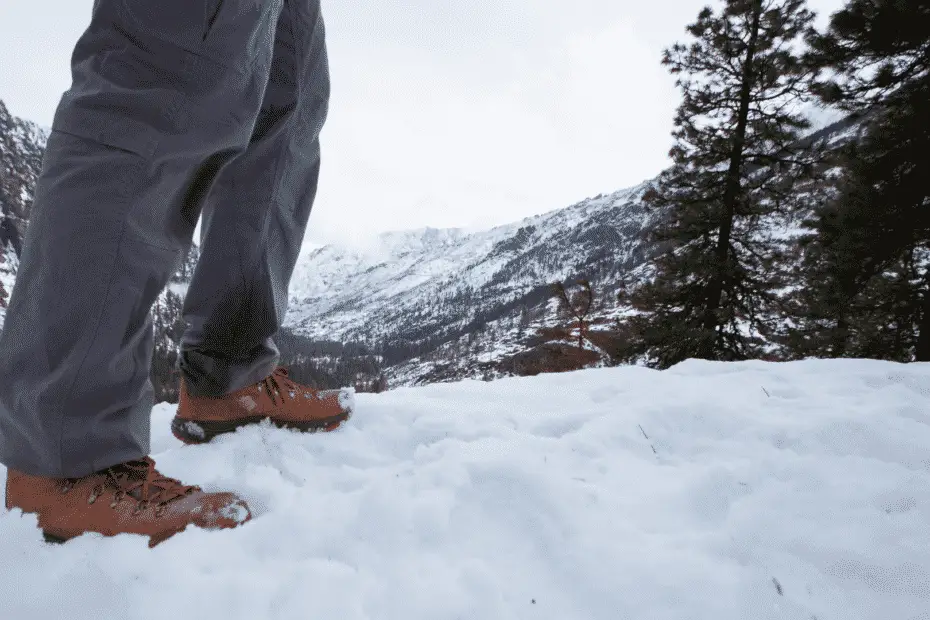I’m often tempted to wear my hiking boots in the winter. I have winter boots and work boots, but none of them come close to the comfort of my hiking boots. Their sturdy and weather resistant for 3-season use, but can they handle the cold winter snow?
Do Hiking Boots Work In The Snow? There are better options, but hiking boots will work in the snow. Just make sure they’re waterproof or there’s a light coating of snow if you’re using 3-Season boots. Wear warm merino wool socks and gaiters to keep snow out of your boots.
There are a few things you may want to consider before heading out in a pair of hiking boots. Summer hiking boots don’t have insulation and waterproofing so you’ll need to take extra precautions to keep your feet warm and dry. In the rest of this post I’ll go over ways to increase the warmth of your hiking boots so you can wear them in the snow.
Table Of Contents
Using Hiking Boots In The Snow
You can technically wear hiking boots in the snow, but it depends on what you’re doing. I wouldn’t wear regular old 3-Season hiking boots on a multi-day camping trip, but they’re fine for a short hike or trip through the city.
Your feet are the most important part of your body on a hike. Trudging through snowy trails puts a lot of stress on your feet. Keeping your feet warm and dry is extremely important on a winter hike. A regular old pair of hiking boots is fine in mild snowy weather for an hour or two, but you’ll need dedicated winter boots for a long winter hike or overnight/multi-day winter camping trip.
Most pairs of hiking boots are water-resistant and not completely waterproof. You can find waterproof hiking boots for the summer, but they’ll lead to excessive sweating/condensation. If you already own a pair of waterproof hiking boots those will work down to about 20°F with merino wool socks (my favorite) and gaiters to keep snow out.
Wearing water-resistant boots will be a challenge in the snow. As snow melts it will slowly penetrate into your hiking boots. Your socks will get soaked with water and your feet will freeze. Water-Resistant hiking boots can handle a little bit of snow, but it won’t take long for water to penetrate through the water-resistant layer.
Here are a few tips to increase the warmth of your hiking boots in the snow.
- Wear merino wool socks to keep your feet warm and dry. Merino wool resists moisture and retains its insulation when wet.
- Gaiters keep snow out of short ankle high hiking boots.
- Wool shoe inserts help retain heat inside your shoe. It’s another layer of insulation between your feet and the cold ground.
- Use durable water repellant sprays to improve the waterproofing in your hiking boots. They won’t be perfectly waterproof, but it will help keep snow from penetrating into your shoe.
You need a pair of insulated waterproof boots if you’ll be out in the snow for more than an hour or two. A good pair of winter hiking boots will be waterproof and lined with warm insulation. Wool shoe inserts, gaiters, and merino wool socks will help on short hikes, but you need to invest in a pair of waterproof winter boot if you’ll be hiking through deep snow or spending hours on the trail.
Wear Merino Wool Socks With Hiking Boots In The Snow
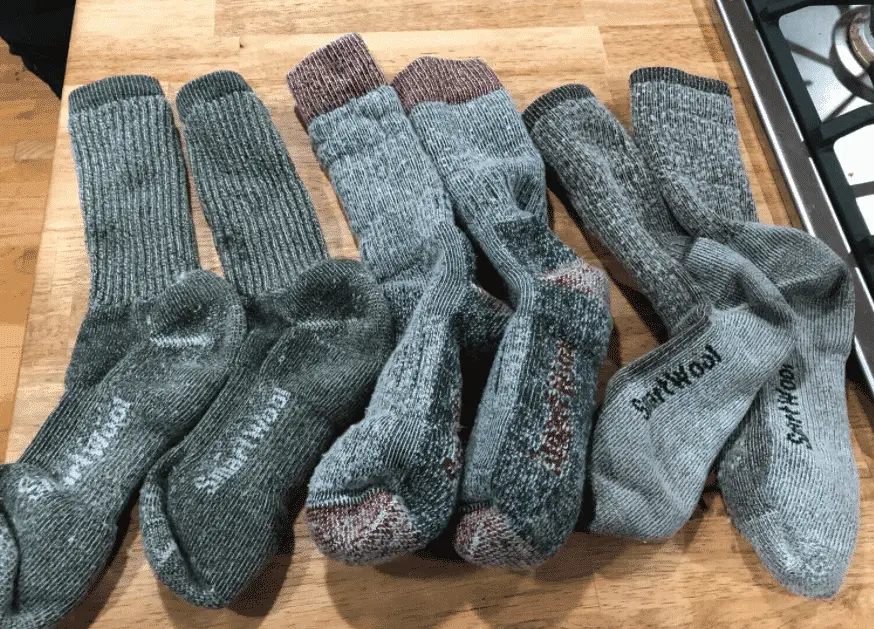
Merino wool socks serve 3 very important purposes in the winter. They’re extremely warm compared to cotton and synthetic socks. Wool resists water and can absorb up to 35% of it’s weight in water without feeling wet. Merino wool is one of the only insulating layers that retains heat when wet.
So it’s extremely important to wear merino wool socks if you’re wearing water-resistant 3-Season hiking boots in the winter. It doesn’t matter how thick and warm your cotton or synthetic socks are. Your feet will be freezing wet the second your feet get soaked with snow.
Gaiters Keep Snow Out Of Your Hiking Boots
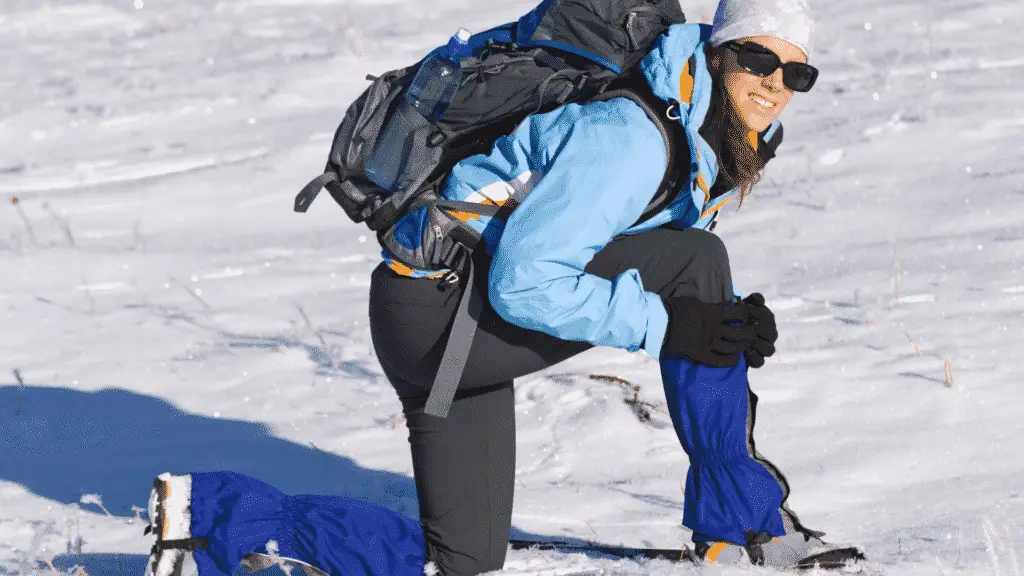
Winter hiking boots typically run a few inches above your ankle, but summer boots will be cut off at the ankle. That’s fine in light snow, but you’ll need to find a way to keep snow out of your boots in deep snow.
Buy a pair of gaiters to keep snow out of your hiking boots. Look for a pair of insulated snow gaiters to keep snow out of your shoes. You can find insulated gaiters on Amazon in the $20-$40 range. There’s no need to waste your money on expensive snow gaiters.
I would buy a pair of Columbia Hiking Snow Boots before spending $80+ on a pair of gaiters. They’re not the most durable snow boots you can find, but they’re warm, waterproof and affordable.
Use Wool Shoe Inserts
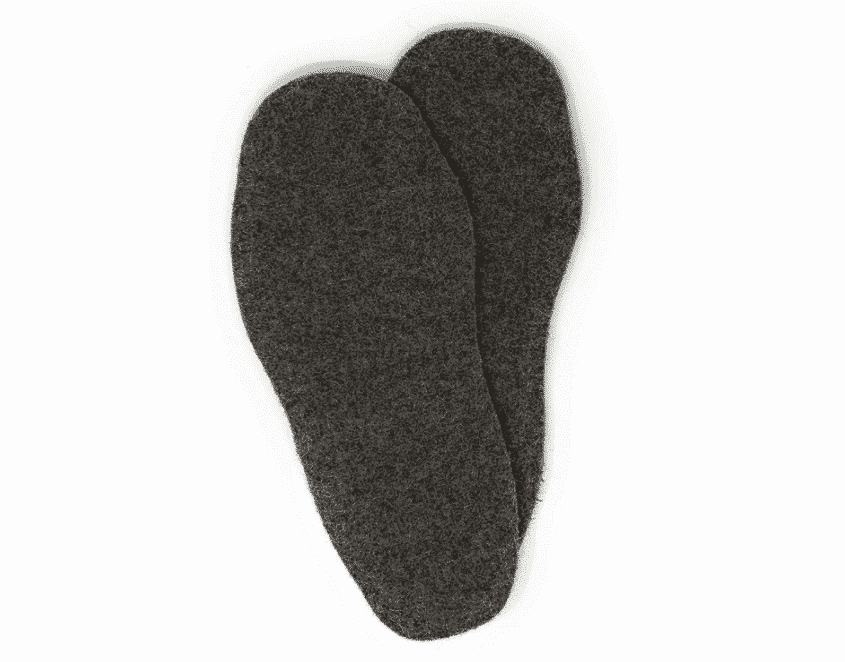
My parents gave me wool shoe inserts as a stocking stuffer a few years ago. They were cheap $10 inserts that they bought off amazon and I didn’t think they would make much of a difference. I was pleasantly surprised by how much warmth they added to my hiking boots.
They added at least 15°F of warmth to my shoes. Wool inserts are just one more layer of insulation between your feet and the freezing cold ground. Pair them with wool socks and it will make a world of difference.
Use A Durable Water Repellent Spray
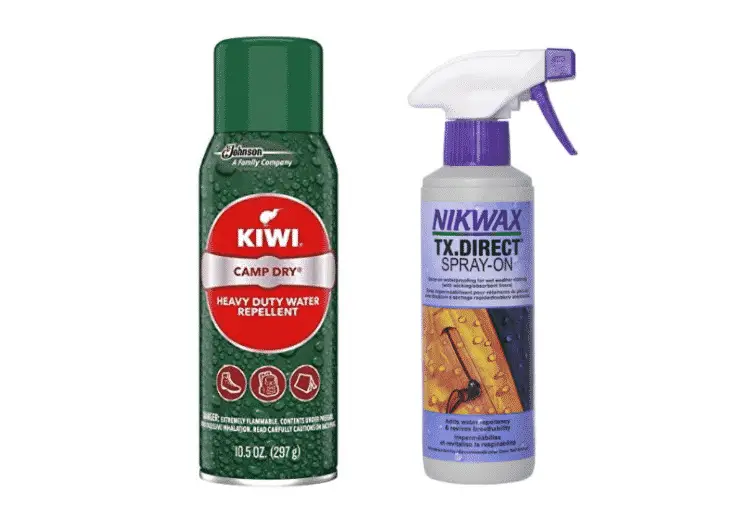
Spray your hiking boots down with a durable water repellent spray. This should help increase the DWR coating on your water-resistant shoes. They won’t be completely waterproof, but it will help keep water out on long winter hikes.
I recommend using either Kiwi Camp Dry or Nikwax Waterproofing Spray. Wax based products (Sno-Seal) also work, but it will damage the ventilation system in your shoes. That’s fine if you’re only using the boots in the winter, but you’ll have sweat and condensation problems in the summer.
Regular Summer Hiking Boots Work In Light Snow and Packed Down Snow
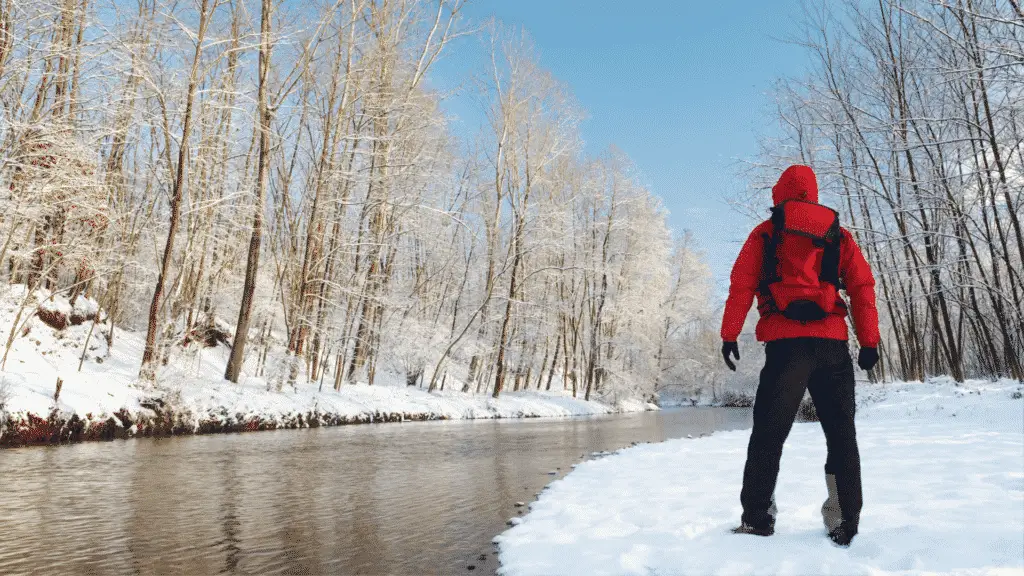
Regular 3-Season hiking boots are fine if there’s not a lot of snow on the ground. I wear my hiking boots around town all winter long. They’re warmer than my tennis shoes, water-resistant, and more comfortable than leather boots. Plus you’re less likely to slip and fall since they offer better traction.
Hiking boots are perfectly fine in a 2-3 inches of snow, slush, and hard packed snow. Ankle high hiking boots just aren’t tall enough to keep snow out of your shoes. That’s wear gaiters and merino wool socks come in. Gaiters keep snow out of your shoes and merino wool socks (I like Smartwool) retain their insulating properties when wet.
Any pair of cheap gaiters will work. I bought a pair of $20 gaiters on amazon and I’ve been using them for the past 5 years. You can buy insulated gaiters, but I don’t think they’re necessary with long johns and merino wool socks.
The only problem with summer hiking boots is that they’re not completely waterproof. That’s great for preventing sweat/condensation in the summer, but water will slowly penetrate into the boots in the winter. Don’t plan on hiking for more than 2-3 hours without a pair of waterproof insulated boots. It won’t take long for your feet to be cold and miserable.
Don’t Use Hiking Boots In Deep Snow
Hiking boots are fine in light snow, but you’ll want a pair of dedicated winter boots in deep snow, longer winter hikes, and multi-day camping trips. A typical pair of hiking boots will be fine on short trips, but it won’t take long for your feet to be wet and cold since they probably won’t be waterproof. Plus you want the insulation of winter hiking boots if you’re hiking in freezing weather.
There are three key components that you need in winter hiking boots. They need to be sturdy with a tall ankle, waterproof, and have an insulated liner (preferably removable).
Winter Hiking Boots Should Be Tall And Sturdy
Winter hiking boots and mountaineering boots will be taller and much sturdier than traditional hiking boots. You need to have sturdy ankle support since it’s easy to lose your footing in the snow. Anything can happen when you’re hiking through ice, slush, and deep snow.
Winter hiking boots are built so they have a sturdy/secure fit around your ankle. I’ve fallen into a 3ft ditch that was completely covered up by the snow. Who knows what would have happened if I wasn’t wearing my winter boots. I could have been stranded with a broken ankle in the middle of nowhere.
The high sturdy ankle also helps keep snow out of your boots. You’ll be fighting a losing battle to stay warm once snow works into your boots and melts. Merino wool socks help keep your feet warm, but you still run the risk of getting frostbite in freezing temperatures.
Winter Hiking Boots Need To Be Waterproof
You don’t want your feet to get wet in the winter. Water speeds up heat loss which leads to numb freezing cold feet and potentially frostbite. I went through a nasty case of frostbite that required debridement when I used to play football in Ohio. They have to scrape the dead skin off your feet which is extremely painful.
A typical pair of summer hiking boots will be water-resistant instead of completely waterproof. Spraying down your boots with a water repellant coating will help, but water will eventually penetrate through the boots. Water in your shoes may be slightly uncomfortable in the summer, but there’s no risk of serious injury.
You need to take frostbite seriously in the winter. Buy a pair of waterproof insulated hiking boots if you plan on hiking for more than a few hours in the winter. A pair of waterproof hiking boots costs less than $100 so it’s not worth risking frostbite on long winter hikes and camping trips.
Columbia’s Hiking Snow boots are an affordable option that’s good enough for most people. They’re waterproof and have 200 grams of insulation. If you plan on hiking on a regular basis you might want to spend the extra money on a pair of Salomon Snow Boots or Merrell Snow Boots that will be more durable.
You can tell how warm the boots are by looking at how many grams the insulation layer is. A 200 gram insulation layer is warm enough for the vast majority of people. The only time you would need warmer boots is if your hiking in temperatures far below freezing.
Keep An Eye On The Insulation Layer
You can get by with any pair of waterproof hiking boots in moderately cold snowy weather. Wear a pair of merino wool socks and use wool shoe inserts. Pair them with a pair of gaiters to keep the snow out and they’ll be warm enough for 20°F weather.
Look into dedicated snow boots with an insulated layer if you’re going on a multi-day camping trip or want to hike in extremely cold weather. A 200 gram insulating liner is warm enough for the vast majority of people. 200 gram boots will keep you warm down to -20°F weather, 400 gram -40°F, 600 gram -60°F.
Consider A Pair Military Combat Boots That Are Designed For Winter
Most people are familiar with the typical standard issue combat boot that you see in the military. It’s fairly obvious when a person is wearing combat boots, but what you don’t realize is there’s actually 2 separate styles of boots issued to military personnel.
The vast majority of our past military conflicts have been in the desert so we’re all familiar with summer combat boots, but there’s also an insulated winter version. It has all the great features you’d see in a standard combat boot, strong ankle support, lightweight design, durable build quality, breathability, comfortable design, etc., but there’s an added layer of insulation and waterproofing.
At this point it should seem fairly obvious that winter combat boots would be a perfect fit for hiking. They’re designed for long distance rucks in the snow, which is basically the same thing as hiking in the winter.
You may want to check out my other post on using military combat boots for hiking for more information. Or you can check out Bellville’s Insulated Combat Boots, and Bates Insulated Combat Boots If you’d like to buy a pair. They’re comparable in price to winter hiking boots and way more comfortable.
